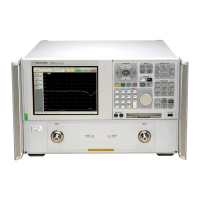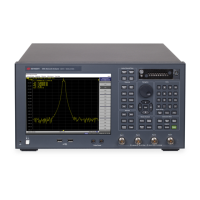Service Guide E8364-90038 5-9
PNA Series Microwave Network Analyzers Theory of Operation
E8362C, E8363C, E8364C Source Group Operation
At the output, an ALC circuit maintains the power level at 5 dBm ± 2 dB for bands 0–1 or 5 dBm ± 2 dB
for bands 2–25. In all bands, the output is sent to the A17–A20 LO distribution path and on to the A27–A30
first converters, as the 1st LO signal.
A17 L.O. Multiplier/Amplifier 10 (LOMA 10)
In bands 0–3, the input signal from the A8 fractional-N synthesizer board is passed through the A17 LOMA
10 unchanged. For all other bands, the signals are doubled, filtered, and amplified. In bands 8–10, 12–18, and
21–25, the signals are again doubled, filtered, and amplified. Together, all of these signal paths create the full
output frequency range of 11 MHz to 10 GHz.
A18 Multiplier/Amplifier 20 (MA 20)
In bands 0–10 and 16–18, the 11 MHz to 10 GHz input frequencies are filtered, amplified, and passed through
the A18 MA 20. In bands 11–15, and 19–25, the signals are doubled, filtered, and amplified.
Together, these signal paths create the full output frequency range of 11 MHz to 20 GHz that is sent to the
A19 splitter.
A19 Splitter
The A19 splitter receives the 11 MHz to 20 GHz LO signal from the A8, A17, and A18 LO generation chain and
divides it into two signals which are routed to the A20 L.O. distribution assembly (LODA). This splitter
configuration provides the highest level of balance and control of the LO signal.
A20 L.O. Distribution Assembly (LODA)
In the A20 LODA, the LO signal is amplified and split to provide balanced LO signals to each of the A27–A30
receiver first converters.
A10 Frequency Reference Board
This assembly provides stable reference frequencies to the rest of the instrument. A high stability 10 MHz
oven-controlled crystal oscillator (OCXO) normally provides the frequency standard. However, if a 10 MHz
external reference signal is detected at the 10 MHz EXT REF IN port on the rear panel, it is used as the
frequency reference instead.
The 10 MHz reference signal is used to phase lock a 100 MHz VCO. This VCO is then used to phase lock a
second VCO at 99.5 MHz. It is also used to provide the 10 MHz EXT REF OUT rear panel signal, reference for
the A11 phase lock board, and a 5 MHz reference for the A6 signal processing ADC module (SPAM) board,
the A8 fractional-N synthesizer board, and the A9 fractional-N synthesizer board (Option 080 only).
The 95.5 MHz reference signal is sent through a divide-by-3 circuit to produce the fourth multiple of the
8.29167 MHz 2nd LO signal which is sent to the A35 receiver motherboard. The 100 MHz reference signal is
sent through a divide-by-12 circuit to produce the
8.3333 MHz phase lock reference signal which is sent to the A11 phase lock board.

